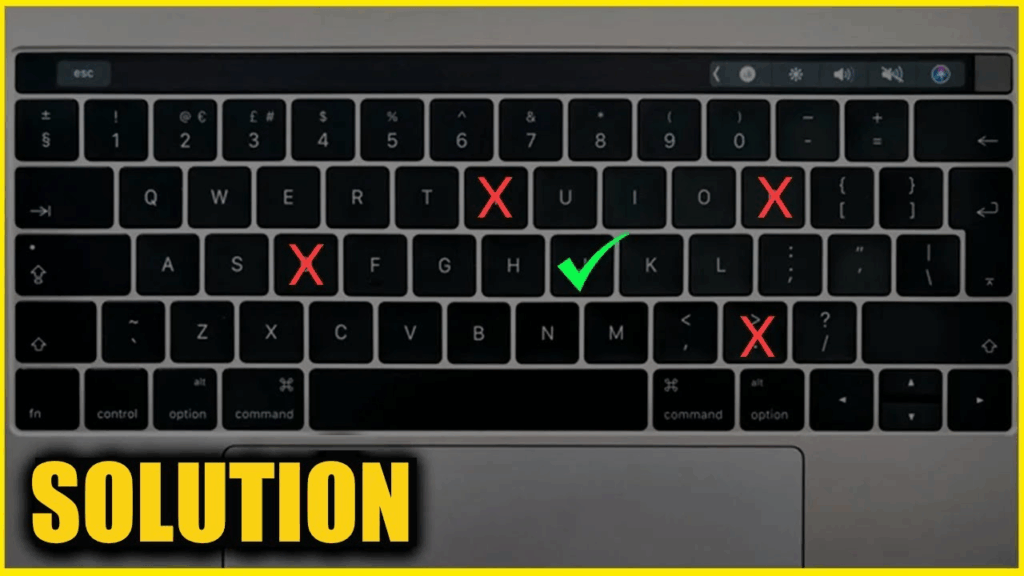A keyboard not working is one of the most annoying computer problems you can face. You sit down to work, start typing, and nothing happens. Or maybe some keys work but others don’t. This problem can turn a simple task into a huge headache.
Don’t worry though. Most keyboard problems have simple fixes. You don’t need to be a tech expert to solve them. In this guide, we’ll walk through the most common reasons why keyboards stop working and show you how to fix them step by step.

Quick Checks Before You Start Troubleshooting
Before diving into complex solutions, try these simple checks first. They might save you a lot of time.
Check Your Connection
First, make sure your keyboard is properly connected. If you have a wired keyboard, check that the USB cable is firmly plugged in. Try unplugging it and plugging it back in. Sometimes the connection just gets loose.
For wireless keyboards, check if the batteries are dead. This is the most common reason why wireless keyboards stop working. Replace the batteries with fresh ones and see if that fixes the problem.
Test Different USB Ports
If your wired keyboard still doesn’t work, try a different USB port. Sometimes one port stops working while others are fine. This quick test can tell you if the problem is with your keyboard or your computer.
Try Your Keyboard on Another Computer
If you have access to another computer, plug your keyboard into it. If the keyboard works fine on the other computer, then the problem is with your original computer. If it doesn’t work there either, the keyboard itself has a problem.
Common Software Issues That Stop Keyboards
Many keyboard problems come from software issues rather than hardware problems. These are usually easier to fix.
Restart Your Computer
This might sound too simple, but restarting your computer fixes many keyboard problems. When you restart, your computer reloads all its drivers and clears any temporary glitches that might be causing the problem.
Save any important work first, then restart your computer completely. Don’t just put it to sleep or use hibernate mode. Do a full shutdown and startup.
Update Your Keyboard Drivers
Drivers are small programs that help your computer talk to your keyboard. If these drivers get corrupted or outdated, your keyboard might stop working properly.
To update your drivers on Windows, right-click on the Start button and select “Device Manager.” Look for “Keyboards” in the list and expand it. Right-click on your keyboard and select “Update driver.” Let Windows search for the best driver automatically.
Check for Stuck Keys
Sometimes keys get physically stuck, which can cause your entire keyboard to act strange. Look at each key to see if any are pressed down or stuck. Gently try to lift any stuck keys. If you need more help with this, check out our guide on how to unlock keyboard issues.
Windows-Specific Keyboard Problems
Windows computers can have unique keyboard issues. Here are the most common ones and how to fix them.
Filter Keys Might Be Turned On
Windows has a feature called Filter Keys that ignores brief or repeated keystrokes. This feature helps people with hand tremors, but it can make your keyboard seem broken if it’s turned on by accident.
To turn off Filter Keys, go to Settings > Ease of Access > Keyboard. Look for “Use Filter Keys” and make sure it’s turned off. You can also press and hold the right Shift key for 8 seconds to toggle this feature.
Sticky Keys Causing Problems
Sticky Keys is another Windows feature that can make your keyboard act strange. It makes modifier keys like Ctrl, Alt, and Shift “stick” so you don’t have to hold them down.
To turn off Sticky Keys, go to Settings > Ease of Access > Keyboard. Turn off “Use Sticky Keys.” You can also press the Shift key five times quickly to toggle this feature.
Wrong Language Settings
If your keyboard is typing the wrong characters, you might have the wrong language selected. Check the language indicator in your taskbar (usually shows “ENG” for English). If it shows something else, click on it and select the correct language.
Hardware Problems and Solutions
Sometimes the problem is with the keyboard hardware itself. These issues usually need different solutions.
Cleaning Your Keyboard
Dust, crumbs, and spills can make keys stop working. Turn your keyboard upside down and shake it gently to remove loose debris. Use compressed air to blow out dust from between the keys.
For sticky spills, you might need to remove individual keys for cleaning. Be very careful when doing this, as keys can break easily. Take a photo before removing keys so you remember where they go.
Worn Out Keys
If you’ve had your keyboard for many years, some keys might be worn out. This is especially common with frequently used keys like the spacebar, Enter key, and common letters like E, A, and S.
Unfortunately, there’s no easy fix for worn-out keys. You’ll either need to replace individual keys (if possible) or get a new keyboard.
Water Damage
If you spilled liquid on your keyboard, act fast. Unplug the keyboard immediately and turn it upside down to drain the liquid. Don’t use it until it’s completely dry, which can take 24-48 hours.
For wireless keyboards, remove the batteries right away. This prevents the liquid from causing electrical damage to the circuits.
Brand-Specific Issues
Different keyboard brands can have unique problems. Here are solutions for common brand-specific issues.
Logitech Keyboard Problems
Logitech keyboards sometimes have connection issues, especially wireless models. If your Logitech keyboard stops working, try re-pairing it with the receiver. Most Logitech keyboards have a small button on the bottom that you press to start pairing mode.
For more detailed help with Logitech keyboard issues, check out our guide on why your Logitech keyboard not connecting can be so frustrating.
Gaming Keyboard Issues
Gaming keyboards often come with special software that can sometimes cause problems. If your gaming keyboard stops working, try uninstalling and reinstalling the keyboard software.
Also check if your gaming keyboard has different modes or profiles. You might have accidentally switched to a different profile that has different key mappings.
Advanced Troubleshooting Steps
If the basic fixes didn’t work, try these more advanced solutions.
System File Checker
Windows has a built-in tool that can fix corrupted system files. These corrupted files might be causing your keyboard problems.
Open Command Prompt as an administrator and type “sfc /scannow” then press Enter. This scan can take 30 minutes or more, so be patient. If it finds and fixes problems, restart your computer.
Check for Malware
Sometimes malware can interfere with your keyboard. Run a full antivirus scan to make sure your computer isn’t infected. Windows Defender can do this, or you can use another antivirus program.
Update Windows
Make sure your Windows is up to date. Sometimes Microsoft releases updates that fix keyboard problems. Go to Settings > Update & Security > Windows Update and check for updates.
When You Need Professional Help
Some keyboard problems need professional repair or replacement. Here’s when to consider getting help.
Laptop Keyboard Issues
Laptop keyboards are much harder to fix than desktop keyboards. If multiple keys on your laptop keyboard aren’t working, you might need professional repair. The entire keyboard assembly might need replacement.
Before paying for expensive repairs, consider using an external USB keyboard as a temporary or permanent solution. This is often cheaper than fixing the laptop keyboard.
Expensive Gaming Keyboards
If you have an expensive gaming or mechanical keyboard that’s not working, check if it’s still under warranty. Many high-end keyboards come with multi-year warranties that cover hardware failures.
Don’t try to fix expensive keyboards yourself unless you’re confident in your skills. The repair cost might be worth it compared to buying a new keyboard.
Preventing Future Keyboard Problems
Once you get your keyboard working again, take steps to prevent future problems.
Regular Cleaning
Clean your keyboard regularly to prevent dust and debris buildup. Use compressed air monthly and wipe down the keys with a slightly damp cloth.
Avoid eating over your keyboard. Crumbs are one of the main causes of sticky or non-working keys.
Gentle Use
Don’t bang on your keys or press them harder than necessary. This can wear out the key switches faster and cause premature failure.
If you’re a heavy typist, consider investing in a mechanical keyboard. These are designed to handle millions of keystrokes and usually last much longer than membrane keyboards.
Keep Software Updated
Keep your computer’s operating system and drivers updated. This prevents many software-related keyboard problems before they start.
Testing Your Keyboard
After trying these fixes, you’ll want to test if your keyboard is working properly. You can test individual keys and functions to make sure everything works correctly. A keyboard tester can help you check if all your keys are responding properly.
Test common functions like typing letters, numbers, and special characters. Also test modifier keys like Ctrl, Alt, and Shift. Make sure keyboard shortcuts still work, such as switching tabs with keyboard shortcuts.
Final Thoughts on Fixing Keyboard Problems
A keyboard not working doesn’t have to ruin your day. Most problems have simple solutions that you can do yourself. Start with the basic checks like connections and batteries, then move on to software solutions if needed.
Remember that patience is key when troubleshooting. Don’t try all the solutions at once. Try one fix at a time and test your keyboard after each attempt. This way, you’ll know which solution actually worked.
If your keyboard has special features like backlighting, make sure to test those too. You might need to turn on keyboard light features separately after fixing the main typing problem.
Most importantly, don’t panic if your keyboard stops working. With the right approach and a little patience, you can usually get it working again without spending money on repairs or a new keyboard.
